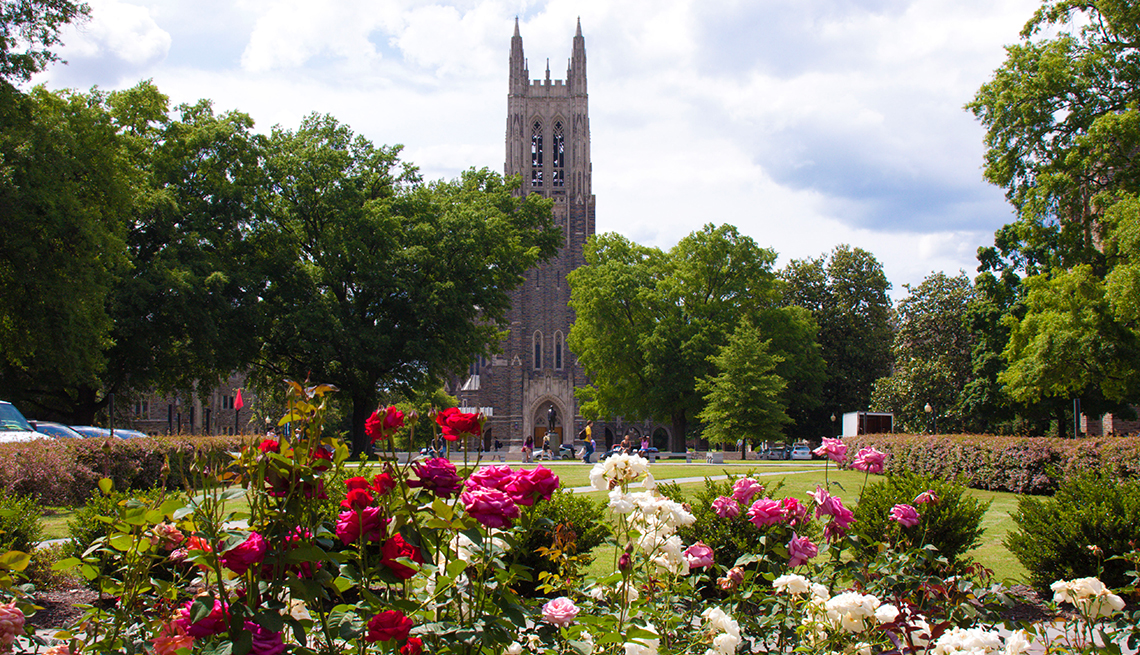
North Carolina’s Research Triangle Offers Delightful Exploration
- Select a language for the TTS:
- UK English Female
- UK English Male
- US English Female
- US English Male
- Australian Female
- Australian Male
- Language selected: (auto detect) - EN
Play all audios:

The Duke University campus in Durham, N. C., features stunning architecture and lovely gardens to explore. Frank Tozler/Alamy Facebook Twitter LinkedIn
I’ve always loved college towns and walking their beautifully landscaped campuses, botanical gardens and arboreta, as well as sampling their cultural offerings and diverse cuisine. Called
the “Research Triangle,” North Carolina’s triumvirate of academic cities — Chapel Hill, Raleigh and Durham, home to the University of North Carolina, North Carolina State University and Duke
University, respectively — offer an array of sights and tastes to explore.
A cultural gem, UNC’s Ackland Art Museum offers free admission and houses more than 20,000 works of art. Courtesy Bower Chapel Hill
I fuel my first morning in Chapel Hill at the Carolina Coffee Shop on East Franklin Street, the UNC student-focused artery that fronts McCorkle Place. After breakfast, I walk around the
corner to The Ackland, UNC’s art museum that is both a teaching facility and public gallery. There, I take in “Aligned by the Sun (Through the Revolution),” a compelling video installation
of overlapping sunsets recorded by artists in more than 200 countries. The museum also features a permanent collection of more than 20,000 pieces, plus traveling exhibitions in a wide range
of mediums, so there’s plenty to see and explore before heading back outdoors toward the university’s Coker Arboretum.
On the way, I pass the Morehead Planetarium and Science Center, a public education and school research facility with installations such as the new Breakthrough Hub, a series of interactive
exhibits that detail the work of UNC researchers, and the GSK Fulldome Theater, host to an array of visual programs focused on the earth and beyond.
Coker Arboretum is managed by the North Carolina Botanical Garden, an extension of UNC. Exhaustively exploring the arboretum's 5 acres of varied green spaces could take days, but I’m
content to meander within three distinct reserves: the campus arboretum, Battle Park and the North Carolina Botanical Garden itself.
Unlike the symmetrical brick byways found on McCorkle Place, the Coker’s nature trails prescribe gentle arcs seemingly leading nowhere in particular, until, like the best secret gardens, I
happen upon the Central Lawn, Stone Gathering Circle and, my favorite, Abundance of Springs. This central channel is what remains of the historic bog that Dr. William Coker, UNC’s first
professor of botany, used as his canvas to compose this verdant landscape and study site. After pausing to admire the overcup oak — a record-sized, swampland specimen that predates the
arboretum — I continue a couple of blocks east to Battle Park where I continue my late morning walk.
Battle Park is named for Kemp Plummer Battle, who served as UNC’s president from 1876 to 1891. Battle worked to establish a wild space that encouraged students and faculty to take time in
nature. The 93-acre park is a perfect example of a southeastern mixed hardwood forest, oaks, hickories and other broadleaf trees teeming with bird song and the din of annual cicadas. I walk
the 1.5-mile gently undulating Battle Branch Trail, stopping to locate a calling pileated woodpecker when four white-tailed deer appear on a slope 20 feet above me, their antlers shrouded in
late summer velvet.
After admiring the deer, bathed in the morning sun, I retrace my steps to the corner of East Franklin and Columbia for an order of wild mushroom grit cakes at Top of the Hill Restaurant &
Brewery, a local institution accented in baby blue and Tar Heel sports memorabilia. After lunch, I'm off to flex my legs with one more flora foray.
Located just a few miles outside of town, the North Carolina Botanical Garden is a must-visit for anyone interested in the state’s diverse ecosystems. Founded in 1927, the garden planners’
goal was to include every North Carolina native plant species in one location. I spend a good 20 minutes in optical pursuit of a swallowtail butterfly feeding on Joe Pye weed within the
coastal plain habitat, then commit twice as much time trying to capture close-ups of bulbous bumble bees pollinating a stand of tiger lilies in the courtyard gardens.
Come evening, I opt for a bowl of delicious mussels at Market and Moss, located 3 miles from the NC Botanical Garden in Southern Village.
